Around the III Centenary of the canonization of St. Francis Xavier in Pamplona
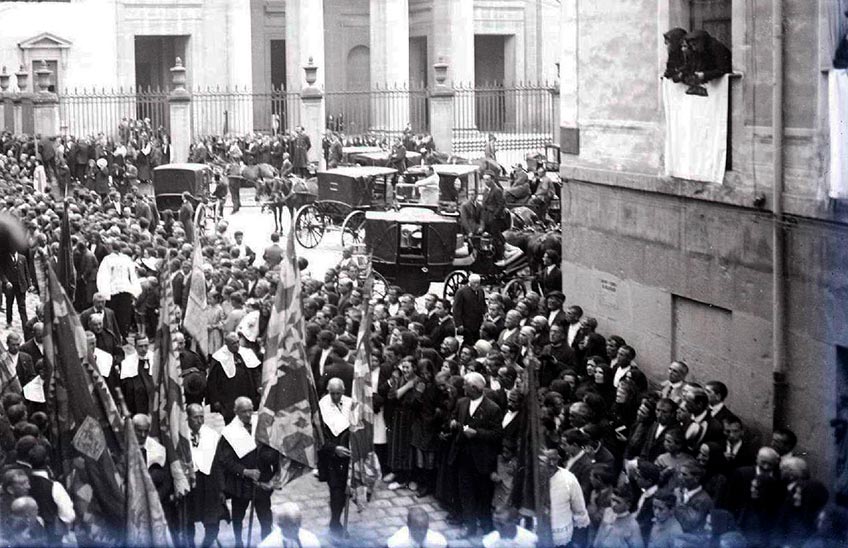
PhotoJoséMartínez Berasáin. file General of Navarre/Start of the procession from Pamplona Cathedral on 24th September 1922, with the flags of the municipalities. The photograph shows those of the Roncal Valley.
A century ago, the Xavierist experience among a large number of Navarrese people was intense. The great pilgrimages to the castle at the end of the 19th century and the reconstruction of the building and the new basilica at the expense of the Duchess of Villahermosa were well remembered. The Jesuits' high school in Tudela was educating a large part of the elite and the Pamplona archconfraternity was experiencing excellent times. Some decisions of the Church, both universal and diocesan, gave impetus to this atmosphere. In 1904, the Navarrese saint was named patron of the works of the Propagation of the Faith, in 1922 he was declared a Jubilee by Benedict XV and, a little later, in 1927, Javier was named patron of all the missions. The bishop of Pamplona, Fray José López y Mendoza, designated 3 December as a feast day in 1918. The same prelate also published the order on the Bishopric's bulletin for the celebration of the novena of grace, which was obligatory in all the churches of the diocese. In 1926, the new bishop, Mateo Múgica, prescribed that at the end of the rosary, the Our Father, Hail Mary and Glory be for the missions should be recited, entrusting the petition to St. Francis Xavier.
Memories of that centenary include the pilgrimage of the Cajas Rurales to the castle in mid-May, the commemorative medal according to design by Julio Arrieta, the premiere of Jenaro Xavier Vallejos' play "Volcán de Amor", at the Gayarre Theatre, and the official anthem with music by Joaquín Larregla and lyrics by Alberto Pelairea. The festivities and celebrations included the arrival in Navarre of the arm of the saint and the Crucifix of the crab, which were brought from Rome and the Royal Palace in Madrid, by concession of the General of the Society of Jesus and Alfonso XIII, respectively.
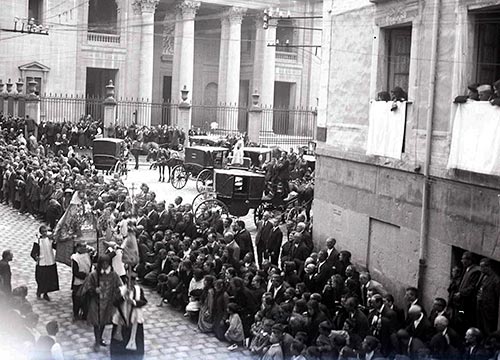
Processional step of the Virgen del Sagrario in the procession of 24 September 1922. Photograph by José Martínez Berasáin. file General of Navarre
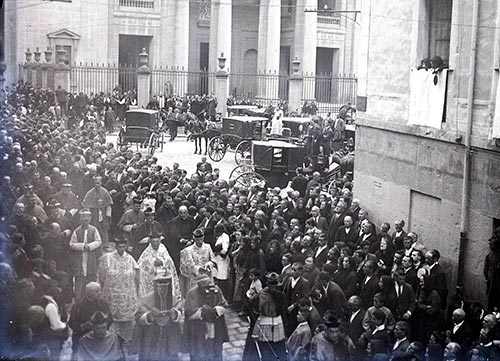
Ecclesiastical authorities in the procession on 24 September 1922. Photograph by José Martínez Berasáin. file General of Navarre
The civic-religious procession in Pamplona on 24 September 1922
In Pamplona, between 21 and 25 September, a solemn triduum organised by the Provincial Council, the National congress of the Missionary Union of the Clergy, the official pilgrimage to Javier and the great civic-religious parade through the streets of the capital of Navarre were held.
On the 23rd, the official pilgrimage to Javier took place, led by the Provincial Council and the Provincial Councils of the Basque provinces, numerous delegations from towns and cities, as well as several bishops. The presence of King Alfonso XIII, who arrived at the castle by car from San Sebastián, added great importance to the festivities. The mass was attended by the Orfeón Pamplonés.
The following day, in Pamplona, after a vigil of the Nocturnal Adoration in the cathedral with 40 flags, the popular and massive act took place, which was a procession through the streets of the city on 24 September. It started at ten o'clock in the morning from the cathedral and ended in front of the Palacio de Diputación, on Paseo de Sarasate.
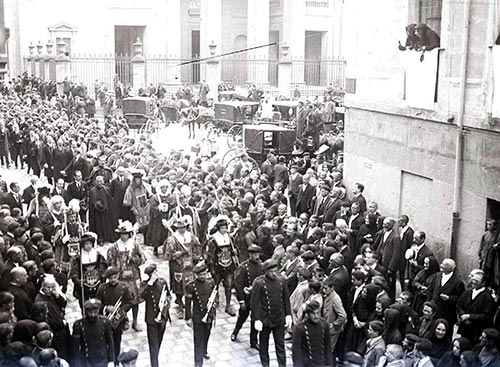
Civil Presidency with the Provincial Councils of Navarre, Guipúzcoa, Vizcaya and Álava in the procession of 24 September 1922. Photograph by José Martínez Berasáin. file General of Navarre
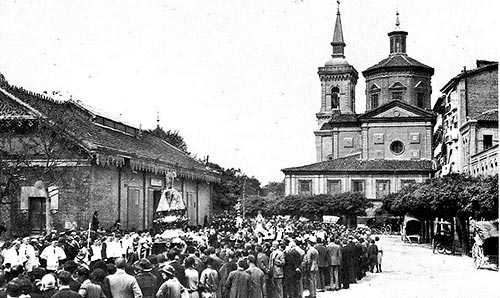
Procession on 24 September 1922 after picking up the co-patron saint San Fermín in the church of San Lorenzo. The images of San Miguel de Aralar and the Virgen del Sagrario can be seen behind the saint. Photo collection Arazuri
The authorities set off for the cathedral from the palace of the Diputación Foral. The latter corporation, together with the Pamplona City Council, the civil governor and the Provincial Councils of Vizcaya, Álava and Guipúzcoa with their maceros, miñones and miqueletes, paraded with the accompaniment of a brass band and preceded by the clarinets of the Provincial Council of Vizcaya. The civic-religious parade started from the cathedral, specifically from place de San José. The balconies of the streets and squares were adorned with banners and hangings, while the bells were rung and tolled. The grave sound of the cathedral's "María" with its severe tolling shocked some of the chroniclers of the event.
The parade included a picket with four cavalry horses from the Almansa Cavalry Regiment, the Giants of Pamplona with bagpipes and drums, and the Pamplonesa with 2,000 children from the Santa Infancia, formed in rows of four, carrying posters alluding to the missions. They were followed by the flags of Catholic trade unions, brotherhoods and confraternities, commissions from two hundred Navarrese town councils with their corresponding flags. Father Astáin states that issue was slightly higher, at 215. The procession was followed by the municipal corporation of Pamplona, priests and religious communities. The edition of Diario de Navarra of 26 September 1922 listed all the municipal flags that took part in the parade. In La Avalancha it adds: "There the victorious flags of the Roncal valley, those that were covered in glory in days of struggle, whose taffetas bear the stamp of centuries. There the prestigious flags of the towns and villages of our merindades; there the banners that denote patriotism and religion, because many of them, with their heroic coats of arms, bear the images of the patron saints of the municipalities". The Jesuit chronicler Constancio Eguía Ruiz published the following: "These are, so to speak, the communities of Navarre, these are the insignia of its towns, villages, cities and merindades. On the old taffeta of their flags they bear embroidered signs of glory: some, like the Roncaleses, wear their regional-coloured grade on their clothes; many bear the images of their patron saints on their coats of arms... on their sturdy bodies, they all carry ensigns of patriotism and faith. On their sturdy bodies and in their firm gaze they bear the imprint of the castiza race...".
Together with the images of San Miguel de Aralar, the cathedral's Virgen del Sagrario -preceded by her squire- and San Fermín, who was incorporated into the parish of San Lorenzo, the cathedral chapter marched. The ecclesiastical presidency was held by the Cardinal of Zaragoza (Juan Soldevila), the Archbishop of Seville (Eustaquio Ilundáin) and other bishops. They all took it in turns to carry the arm of the saint and the Crucifix of the crab. Also taking part in the march were the board of the Centenary, a commission from the Caja de Ahorros de Navarra - founded that same year -, the Provincial Councils, the civil governor and other judicial and military authorities. At different parts of the route, marches and different scores were performed by other bands, such as those of Estella, Sangüesa and other military bands. The Regiment of the Constitution, with flag and brass band, also honoured the relic and the Christ of the crab.
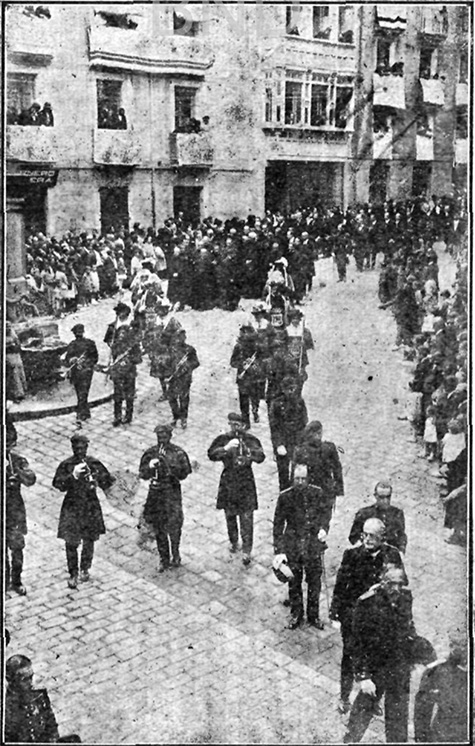
Miqueletes and miñones in the procession. Photograph published in La Avalancha ( 7-XII-1922)
At the end of the parade, the images of San Fermín, the Virgin and Saint Michael of Aralar were placed at the foot of the Monument to the Fueros. The resigned bishop of Oviedo, Francisco Javier Baztán y Urniza, a native of Sada, "with an enthusiastic and young heart in an old body", proclaimed "Vivas" (Long Live), which was responded to with force by those present. position According to Father Astráin, the "brief but inflammatory" address was given by the Jesuit Víctor Elizondo, who shortly afterwards left for China "to give a practical example of his preaching". The Provincial Councils and the representatives of the heads of the merindades entered the foral palace.
From the main balcony of the Palacio de Diputación, the 25,000 people gathered received the blessing with the saint's arm, while the flags paid homage "to the dust as a sign of respect" and the military and civilian bands played the Marcha Real (Royal March). At the end, the images of the Virgen del Sagrario and San Fermín were taken in procession to their places of worship, the cathedral and the parish church of San Lorenzo, respectively, while the image of the Angel of Aralar was taken to residency program de los Capuchinos.
The procession, according to Diario de Navarra (26 September 1922), was "grandiose, solemn, very colourful, as nothing like it could ever be done anywhere, except for the lack of elements, for the spirit of discipline and organisation, which in this country is ahead of the rest". In the Catholic-propagandistic organ La Avalanche (14 October 1922), he pointed out: "It does not seem but that the soul of Navarre, after three centuries in which the Church raised to the lofty heights of the altars that brave Christian, fortunate emulator of the apostles and determined companion of the martyrs, awoke in admiration of the spiritual greatness of her precluded son and came to the capital, as a loving matron of her holy son, to surround his figure with splendours of love and to crown with an immortal crown of glory the astonishingly divine spirit that brought the fire of Christ's charity to the pagan peoples of the East....".
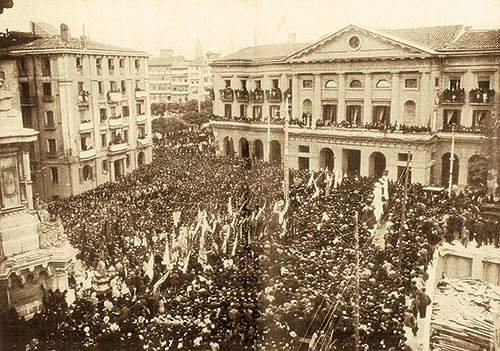
Act of blessing with the relic of Saint Francis Xavier and the Christ of the crab from the Palacio de Diputación, after the procession, in Pamplona on 24 September 1922. Photograph by Alfonso Ciarán (Madrid)
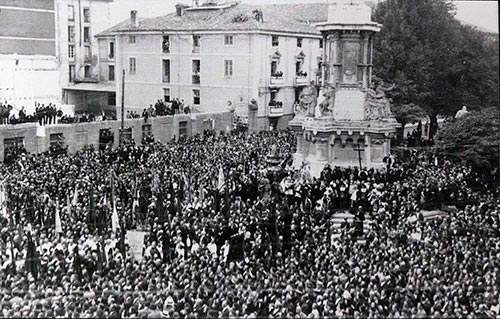
Attendees at the act of blessing with the relic of Saint Francis Xavier and the Christ of the Crab, 24 September 1922. The images of San Fermín, the Virgen del Sagrario and San Miguel de Aralar, who had taken part in the procession, can be seen under the monument to the Fueros. Photographic library file Municipal of Pamplona
To find out more
Diario de Navarra, 26 September 1922.
EGUÍA RUIZ, C., Reliquias de San Ignacio de Loyola y San Francisco Javier. Su recorrido triunfal por España, Madrid, Blass, S. A. Tipográfica, 1924.
FERNÁNDEZ GRACIA, R., San Francisco Javier Patron Saint of Navarre. Fiesta, religiosidad e iconografía, Pamplona, Government of Navarre, 2006.
FERNÁNDEZ GRACIA, R., "Heritage and identity (62). San Francisco Javier, 1922". Diario de Navarra, 11 March 2022, pp. 58-59.
GOÑI GAZTAMBIDE, J., History of the bishops of Pamplona. XI. Siglo XX, Pamplona, Eunsa, 1999.
La Avalancha, 14th October 1922
